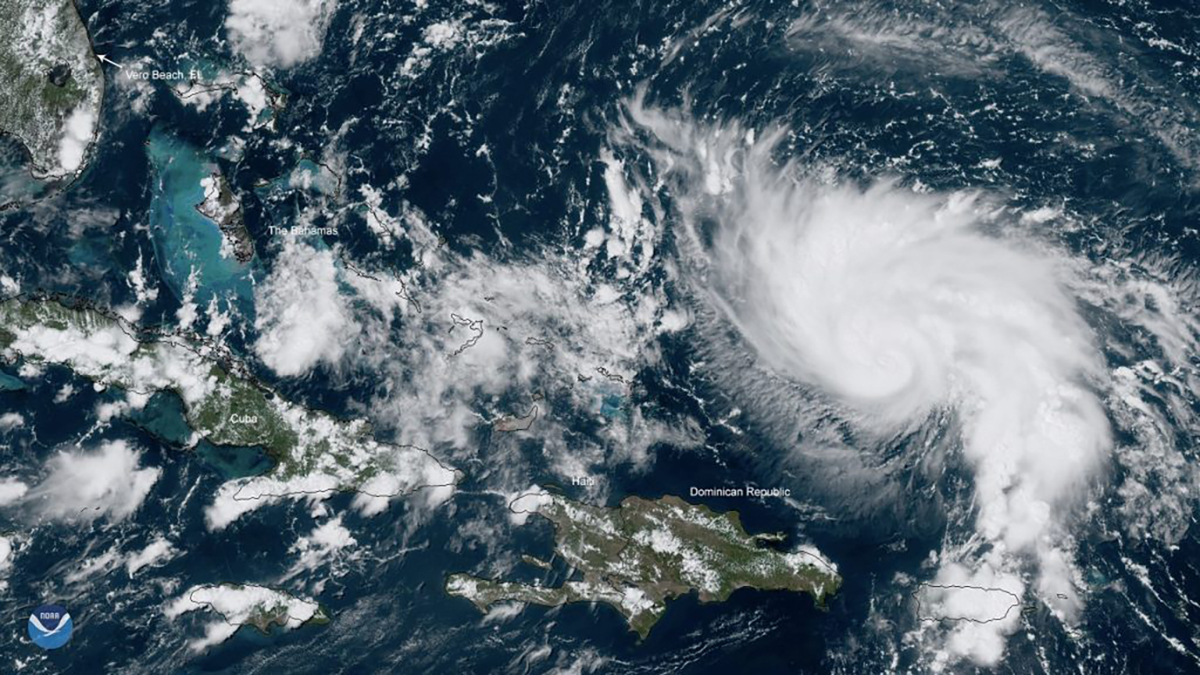Korty And NSF-Funded Team Studying Hurricane Risk Prediction In A Changing Climate
Texas A&M and Texas A&M Galveston researchers will be part of a team using historical and long-term reconstructions of hurricane activity in the western North Atlantic to ultimately improve hurricane preparedness and resilience.
Dec 9, 2019

Satellite view of Hurricane Dorian on Aug. 29, 2019. Dorian passed directly over one of the blue hole sites that Dr. Peter van Hengstum has studied in the Bahamas. (Photo credit: NOAA Environmental Visualization Laboratory.)
Hurricane preparedness is a major priority for coastal communities all along the United States’ shores. A team of interdisciplinary researchers recently began a new project working to ensure that the hurricane risk predictions these communities depend on are as accurate as possible, informed by historical data, and accounting for climate change-driven effects on hurricanes’ climatic drivers.
Titled “Predicting Hurricane Risk Along the United States East Coast in a Changing Climate,” the team’s project was recently funded by the National Science Foundation (NSF).
Dr. Robert Korty, associate professor in the Department of Atmospheric Sciences at Texas A&M University is part of the research team. Texas A&M Galveston’s Dr. Peter van Hengstum, associate professor in the Department of Marine Sciences, who holds a joint appointment in the Texas A&M Department of Oceanography, is on the research team as well.
“Changes to hurricane activity in the coming century have the potential to substantially impact the entire economic landscape of American coastal regions,” Korty said. “We know that storms in a warming climate carry increased risks of flooding in a general sense, but our ability to predict how quickly these hazards are changing has been hampered by an incomplete understanding of how variability in ocean circulations interacts with the changing climate.”
Led by Dr. Jeffrey Donnelly of the Woods Hole Oceanographic Institution, the team includes leading researchers in hurricanes, flooding, and coastal geomorphology, Korty said. Dr. Kerry Emanuel of the Massachusetts Institute of Technology, Dr. Kristopher Karnauskas of the University of Colorado Boulder, and Dr. Ning Lin of Princeton University are the other principal collaborators.
The project will use innovative long-term geological reconstructions of hurricane activity preserved in the sediments of blue holes in the western North Atlantic, which extends knowledge of hurricane occurrence back centuries and even millennia. This approach allows assessment of how the risks posed by hurricanes along the east coast of the United States has changed.
“Blue holes are collapsed caves that create a perfect trap for sediments in the coastal zone,” Van Hengstum said. “Hurricane passage deposits a distinct sand layer in the blue hole, so the sediments preserved at the bottom of blue holes preserve a library of hurricane events not recorded in any other way."


The researchers will combine these records with experiments using weather and climate models to simulate how hurricane structure, intensity, and size change in a warming world, to provide improved projections of future hurricane risk.
“One of the unique aspects of this project is that it brings together geologists, meteorologists, and civil engineers to tackle these issues holistically,” Korty said. “Our role at Texas A&M is to simulate storms under future climate scenarios and diagnose the processes that most affect the increased risks from flooding.”
Several students will also be a part of the research, including: Jinjun Liu, graduate student in atmospheric sciences at Texas A&M; Richard Sullivan and Tyler Winkler, oceanography graduate students at Texas A&M; and Sean Buckelew and Lauren Mennen, marine sciences undergraduate student at Texas A&M Galveston.
Many of the lessons learned from this work will be used by the broader scientific community and planners and decision-makers to improve hurricane preparedness and resilience, according to the scientists.
The results will inform risk modeling, which in turn informs the insurance and re-insurance industries, as well as efforts to mitigate tropical cyclone hazards at the city, state and federal levels.
This research was funded by a four-year grant from NSF's Prediction of and Resilience Against Extreme Events (PREEVENTS) program, which supports researchers studying hurricanes, floods, wildfires, earthquakes, coastal erosion, severe thunderstorms and tornadoes, volcanoes, space weather disruption of the power grid, and other natural hazards.
"NSF's support for basic research on natural hazards will help the American people and those around the world better prepare for and respond to disasters," said Justin Lawrence, lead program director for NSF's 2019 PREEVENTS grants. "PREEVENTS projects will provide important information that can be used by communities in the United States and elsewhere to further public safety and protect economies.”
Learn more from the NSF announcement.
By Leslie Lee ‘09
